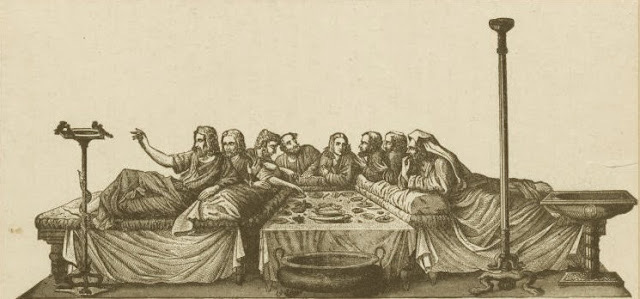WE give little thought to the origin of the table utensils in daily use, but a recent French writer throws interesting light on the subject. The old Romans, it seems, not only breakfasted, but dined and supped, if not in bed, reclining upon couches, and not until the days of Charlemagne were stands introduced, the guests sitting around them upon cushions.
In the Middle Ages, when a table and benches with backs were an innovation, the ultimatum of luxury and ease seemed reached. The food was eaten from a kettle with side-handle, not unlike a porringer, but after a time thick rounds of bread were cut from the loaf to serve as plates.
Of very remote date is the salt-cellar (as the use of salt. belongs to the earliest ages); at Roman and Greek banquets it occupied a prominent place, and was termed by Homer, "divine." The salt cellar was made for the rich from silver or gold, and was a family heirloom. Francis I had several of exquisite workmanship, the chasing credited to Benvenuto Cellini.
At the Louvre are specimens made from faience for the wonderful service of Diana of Portiers or Henry II. In contrast to this elegance, salt-holders were formed from common earthenware, and at the ordinary repasts of the poor pieces of bread were cut and hollowed out, and placed at each plate to hold the salt. Individual, it seems, even if crude No. mention is made of the castor until the sixteenth century, and then it is termed "cruet-stand."
The knife is very old; but not until the tenth century is it classed as a table appointment; while spoons are also very antique, mentioned as early as the seventeenth century . The old Greeks and Romans knew by experience that “fingers were made before forks” and used them accordingly. Even in the Middle Ages a fork was a curio, and to Henry III, we owe its establishment as a table convenience.
From the most remote period comes the drinking-cup, in the Middle Ages formed from precious metals, and later jeweled, inscribed, and ornamented. From fair Venice in the fifteenth century come glasses, probably very unlike the delicate things of beauty and value that we style “Venetian glass,” but nevertheless just an rosy lips quaffed the water and wine then as now, and eyes were as bright, smiles as sweet, and homes as dear in that long ago
When we consider the progress in table appointments – to dainty service at command in this nineteenth century, in contrast with the slender opportunities of the wives of those old Roman and Greeks for handsome entertaining – we resolve with what we have therewith to be content.– The Pottery Gazette (London, Greater London, England) Sat, Apr 1, 1893
Of very remote date is the salt-cellar (as the use of salt. belongs to the earliest ages); at Roman and Greek banquets it occupied a prominent place, and was termed by Homer, "divine." The salt cellar was made for the rich from silver or gold, and was a family heirloom. Francis I had several of exquisite workmanship, the chasing credited to Benvenuto Cellini.
At the Louvre are specimens made from faience for the wonderful service of Diana of Portiers or Henry II. In contrast to this elegance, salt-holders were formed from common earthenware, and at the ordinary repasts of the poor pieces of bread were cut and hollowed out, and placed at each plate to hold the salt. Individual, it seems, even if crude No. mention is made of the castor until the sixteenth century, and then it is termed "cruet-stand."
The knife is very old; but not until the tenth century is it classed as a table appointment; while spoons are also very antique, mentioned as early as the seventeenth century . The old Greeks and Romans knew by experience that “fingers were made before forks” and used them accordingly. Even in the Middle Ages a fork was a curio, and to Henry III, we owe its establishment as a table convenience.
From the most remote period comes the drinking-cup, in the Middle Ages formed from precious metals, and later jeweled, inscribed, and ornamented. From fair Venice in the fifteenth century come glasses, probably very unlike the delicate things of beauty and value that we style “Venetian glass,” but nevertheless just an rosy lips quaffed the water and wine then as now, and eyes were as bright, smiles as sweet, and homes as dear in that long ago
When we consider the progress in table appointments – to dainty service at command in this nineteenth century, in contrast with the slender opportunities of the wives of those old Roman and Greeks for handsome entertaining – we resolve with what we have therewith to be content.– The Pottery Gazette (London, Greater London, England) Sat, Apr 1, 1893
🍽Etiquette Enthusiast, Maura J. Graber, is the Site Editor for the Etiquipedia© Etiquette Encyclopedia

No comments:
Post a Comment
Note: Only a member of this blog may post a comment.